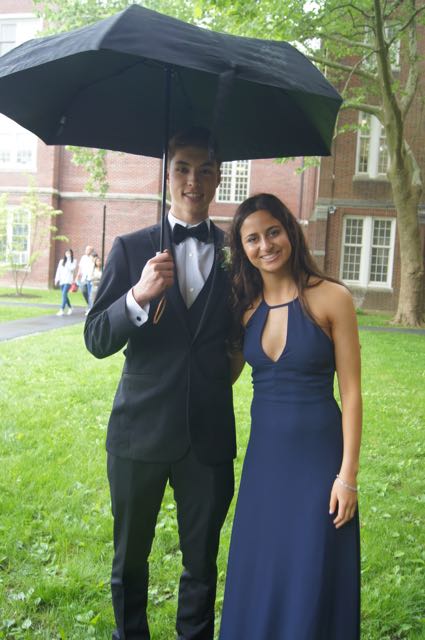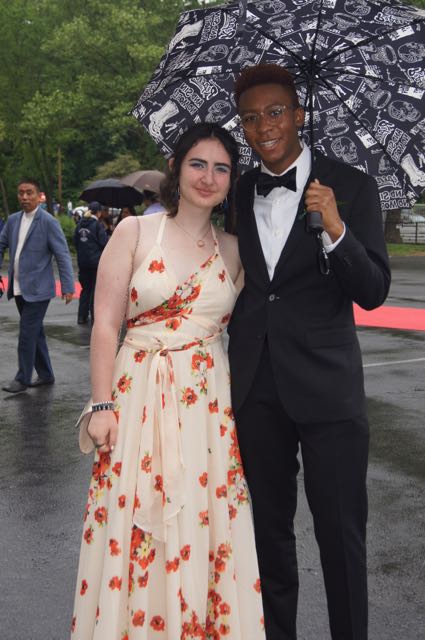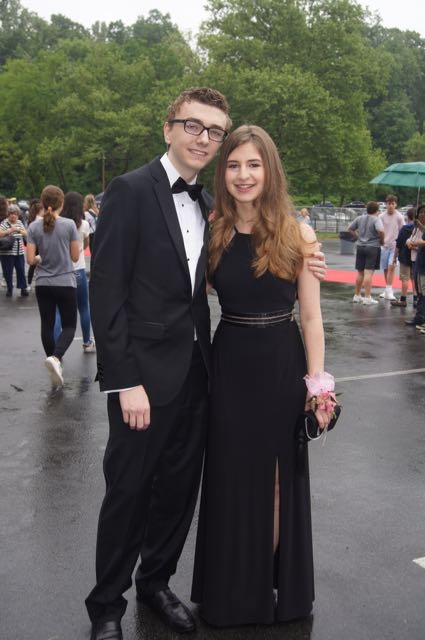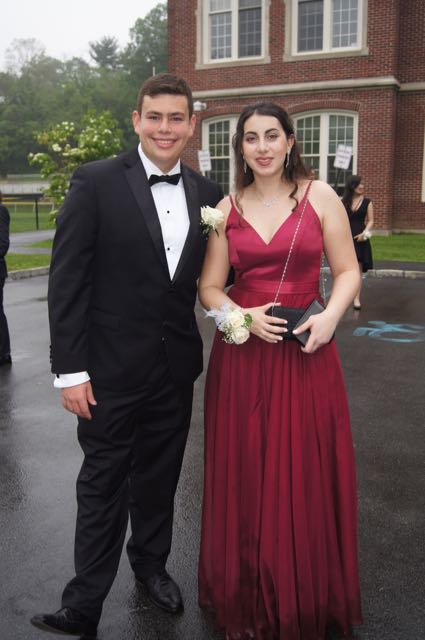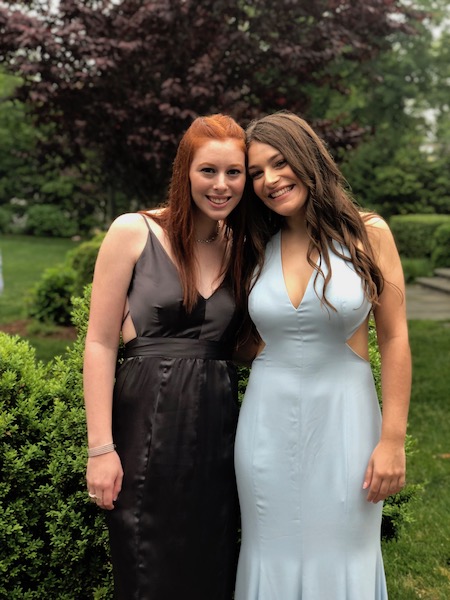Seniors Explore the World of Work During Senior Options
- Details
- Written by Natalie Isak
- Hits: 5066
 Yehuda sits happily in his new high chair designed and built by Friedman. As the school year drew to a close, the senior class was immersed in a mixture of emotions: relief, anticipation, apprehension, and excitement. Yet before Scarsdale seniors could cross the finish line of graduation, they faced their last obstacle: senior options.
Yehuda sits happily in his new high chair designed and built by Friedman. As the school year drew to a close, the senior class was immersed in a mixture of emotions: relief, anticipation, apprehension, and excitement. Yet before Scarsdale seniors could cross the finish line of graduation, they faced their last obstacle: senior options.
For the months of May and June, Scarsdale seniors spent seven weeks, 30 hours a week, in the workforce completing internships or independent projects of their choosing.
Beginning in the winter, seniors were tasked with finding a “mentor” for their internship, any teacher at the high school who they have a close relationship with, to help guide them through the process. Students were then randomly assigned a “case manager” who is in charge of approving their proposals and passing their final projects.
Students then spent the ensuing couple of months finding, researching, and securing an internship. To do so, students found a “sponsor,” or an employee/volunteer at their chosen internship to oversee their work. It is also possible for students to complete independent studies: projects in which approximately 10 hours are spent as structured time related to their study and the other 20 hours are spent alone working on a private project.
This year, Scarsdale seniors’ senior options ran the gamut of interests. Here are some of a few exciting internships and projects:
Anthony D’Ambrosio completed his senior options with Dr. Matusz, an orthopedist. At his internship, he observed and helped Dr. Matusz complete MRIs and X-Rays for his patients.
During his time in the office, D’Ambrosio encountered a number of different spinal injuries and conditions, such as Spinal Stenosis, Spinal Spondylosis, Spinal Slippage, and Herniated Discs.
Although D’Ambrosio spent the majority of his time interacting with patients and aiding Dr. Matusz, he did have the opportunity to watch certain procedures.
D’Ambrosio observed two laminectomies, one rotator cuff repair, and two meniscus repairs.
“Overall I really enjoyed shadowing Dr. Matusz and getting to see the whole process of an injury from diagnosis to recovery,” said D’Ambrosio.
Noah Glantz spent the past seven weeks at Pro Sports Physical Therapy. An athlete himself, Glantz has visited their physical therapy office a shocking 89 times for a variety of different injuries. He had always enjoyed the positive and welcoming environment and felt as if he “owed it to them to work there.” Glantz is also interested in sports, medicine, and interacting with people, so this senior options project was the perfect fit.
At Pro Sports Physical Therapy, Glantz prepared bottles for ultrasounds, met with patients, did laundry and cleaned tables, made ice packs, and shadowed therapists. Over the course of his internship, he learned a variety of different physical therapy techniques, including heat, ice, manual therapy, strength therapy, ultrasounds, and laser.
Not only did Glantz learn technical, hands-on skills, but also how to support patients emotionally. Glantz helped many patients make short-term goals and focus on how far they have come rather than how far they have left.
For Ryan Guo’s senior options, he spent 30% of his time interning as an IT assistant in Scarsdale High School and the remainder of his time on a personal project. Guo expressed interest in creative applications of technology, and this combination of responsibilities exposed him to a number of different skill sets in this field.
At the high school, Guo obtained real world experience working with hardware and software. He spent time reorganizing chromebooks, testing computer programs, installing new software, and researching database effectiveness for the foreign language department. Guo also had the opportunity of redesigning Scarsdale High School’s floor plans to help improve legibility.
For the remainder of his senior options, Guo designed a visual novel. He used python and other coding languages to create special effects, wrote content, created artistic designs for the background, and incorporated audio. Guo said he “enjoyed the autonomy and free time” of his independent project to pursue his passion.
Guo has yet to finish his visual novel and looks forward to completing it this summer.
Jack Lazarus spent his senior options interning for a plumber. This unconventional internship was spurred by his interest in engineering and desire to gain hands-on, applicable experience in the workforce.
During Lazarus’ final presentation, he joked that his friends and family all believed that he spent seven weeks unclogging toilets. Lazarus explained, however, that plumbing encompasses a much broader scope than toilets, but showers, sinks, gas generators, hot water tanks, radiators, and boilers as well.
Lazarus learned how to change flappers and flush valves; unclog drains; fix leaks, snake sinks and sewage pipes; and install sump pumps, new boilers, and new hot water tanks.
“Senior options gave me a look into a profession I had never considered before. The experiences I had gave me a new appreciation for plumbing and showed me just how many professions I take for granted and that many have larger impacts on the world than I thought,” said Lazarus.
Charlotte Moser spent her senior options at Baked In Color. Local resident Julie Waxman,  who began the operation business in May 2016, runs this company. Moser is interested in pursuing a career in medicine, but has always held an interest for baking and business as well.
who began the operation business in May 2016, runs this company. Moser is interested in pursuing a career in medicine, but has always held an interest for baking and business as well.
At Baked In Color, Moser was charged with a variety of responsibilities. She had the opportunity to bake some of Baked In Color’s staple rainbow chocolate chip cookies, those of which the business produces approximately 2,000 cookies per day. Moser also bought and managed baking supplies and helped prepare cookie packaging.
For the majority of her time, Moser helped run Baked In Color’s social media accounts. During her time at the company, she learned the importance of social media exposure for new businesses. Moser helped design aesthetically pleasing cookie promotions to post on the company’s Instagram account.
Caroline Stemerman interned at NM Designs, a budding interior design company. NM Designs incorporates traditional and contemporary elements to create unique designs.
Stemerman had a lot of independence at her internship. She sourced materials, coordinated and attended meetings with clients, created invoices, estimated project costs, and pitched ideas to her boss and clients.
Some of her projects included houses in the Hamptons, Long Island, and New Rochelle. Just as each house was unique, so were the needs of its clients. For instance, Stemerman recalled working with a religious family that could not have the color black in their house. “The most important thing that I learned was that each client has different wants and needs… and I had to learn how to work with that”
Zach Friedman designed and built a high chair for 15-month-old Yehuda. Friedman is interested in adaptive design association and creative engineering, and wanted to spend his senior options creating a physical product.
Yehuda has microcephaly, which causes abnormal brain development. He is smaller than most babies and struggled to sit upright in his previous highchair. Friedman’s solution was to build inserts for Yehuda’s head, neck, hips, and feet.
Friedman developed his prototypes and final product in the design lab at Scarsdale High School. “One of the best parts of this project was being able to work in the new design lab – having all that technology right in front of you makes a huge difference, it really makes the whole experience nicer,” said Friedman.
After designing and building three prototypes, Friedman was finally ready to create his final product. It included Velcro ankle fasteners, a height adjustable footrest, 3D printed footholds, and side inserts. To build the final high chair, Friedman used a number of different technology and tools: everything from a 3D printer to a sewing machine.
Yehuda loved the final product. “He [Yehuda] wasn’t in the best mood, and then he sat in the chair and we put all the inserts in, and you can see his face light up. Without it, he’s really just falling over in his chair and you can tell he’s not really comfortable, but with all the inserts in there, it’s almost like he’s being hugged the entire time and he finally feels comfortable in a chair that fits him,” said Friedman.
To learn more about Friedman’s project, click here.
District Failed to Disclose Mold Testing Results Before Bond Referendum
- Details
- Written by Joanne Wallenstein
- Hits: 4727
 The question about mold at Greenacres School has resurfaced again. At the May 21 meeting of the Scarsdale Board of Education, Greenacres Dad Mitch Kahn inquired about the results of follow-up mold testing that was done at the Greenacres Elementary in January 2018. The re-testing was done after mold was found in the school in October 2017 but the results were never shared with the community. The report was dated January 22, 2018 just two weeks before a community vote on a bond referendum that included plans to renovate Greenacres School, but the testing results were not made available to voters.
The question about mold at Greenacres School has resurfaced again. At the May 21 meeting of the Scarsdale Board of Education, Greenacres Dad Mitch Kahn inquired about the results of follow-up mold testing that was done at the Greenacres Elementary in January 2018. The re-testing was done after mold was found in the school in October 2017 but the results were never shared with the community. The report was dated January 22, 2018 just two weeks before a community vote on a bond referendum that included plans to renovate Greenacres School, but the testing results were not made available to voters.
Kahn said, “I don’t understand why we haven’t been told the results of those tests. Clearly we had to go through a FOIL to get the results of previous tests and we don’t want to have to go through that process every time a test is done. We have an upcoming large renovation and its supposed to have third party testing and we don’t want to have to FOIL the results.”
He continued, “I think the administration has a communications problem. You know these are big issues. You know that parents care. If there are no issues then there should be no problem telling people where we can get the results of these tests…. If we do these tests and we don’t tell anyone the results, does it matter that we do the tests? There are a lot of parents that are worried but are too intimidated to come up here to speak.”
Just hours before the June 11, 2018 meeting of the Board of Education, which was five months after the January environmental report was received, those results were made public. They showed that there was again mold at four of the previous sites at Greenacres School – not at the same levels as previously reported – but present enough to require another disinfection process. Elevated readings were found in Classrooms 2B and 9, in the teacher’s lounge and in the custodial area.
On Monday night, in a discussion of the testing, Assistant Superintendent for Business Stuart Mattey steered away from discussing the results or steps to eliminate the mold and instead focused on future reporting protocols. He said, “The district failed to follow up on IAQ (Indoor Air Quality) testing when we said that we would. This will be a regular agenda item in January and June. All reports will be posted on the website as soon as they are completed. The website has been updated. We included money for environment testing in next year’s budget and John Trenholm will arrange the schedule.”
However, reporting the problem does not solve it. Given that the school is about to undergo a $35 million renovation, Mattey might have addressed how the architects and engineers proposed to get at the source of the mold to stop these re-occurences. The building is known to be on a high water table and has had issues with water infiltration. In November, areas of the building were found to be very humid. Due to the expense, the existing areas of the building will not be air conditioned, which would have lowered the humidity and discouraged the growth of mold.
We followed up with Mattey and posed the following questions in an email on Tuesday June 12, 2018.
Stuart: I was surprised to see mold testing results from January 2018 issued in June, especially in light of a facilities bond vote in February. Information like this might have affected voters' choice.
Here are my questions:
Why were the results held until now?
Elevated readings were found in rooms 2B and 9 and in the teachers’ lounge. The teacher’s lounge is on the opposite side of the building from where the new dehumidifiers will be located. I believe that Room 9 is also above a dirt crawl space.
As you know, three quarters of the building sits on a dirt foundation on a very wet site. Has the district done any testing of the dirt crawl spaces? How can we assess the mold levels there? What are the plans for remediating any mold that may be coming up from this dirt foundation? I assume that BBS has submitted a plan – can that be shared with the public? Is there someone for me to contact at BBS to discuss this issue?
Mold was found in November 2017 and then reappeared in January 2018. Given that the mold appears to be endemic, are we all still comfortable with a renovation in the case that we are unable to eradicate the mold in the building?
Here is Mattey’s response:
Dear Joanne:
Unfortunately, the District failed to circle back to the community regarding the January test results. This was certainly an oversight during an extremely busy period that included budget preparation and the enormous amounts of work prior to the February Bond Referendum. We are thankful to the Scarsdale resident who reminded us at the last Board meeting that the report had not been circulated as intended.
As a result of this experience, the District will now include Environmental Testing Updates twice per year (January and June) to help assure that both the Board and the community are kept abreast of testing results and activities.
In addition, all reports and protocols will now be posted on the website as soon as they have been completed. These can be found in the Facilities & Grounds section, under District Information. (https://www.scarsdaleschools.k12.ny.us/domain/8).
For your information the Indoor Air Quality Protocol states the following:
All the classrooms in the High School and the Middle School will be tested for indoor air quality (IAQ) during the 2018-2019 fiscal year. All elementary school classrooms will be tested for IAQ during the 2019-2020 fiscal year. The District will re-test all classroom areas every 3 years for IAQ issues. The District will enlist the following protocols in the event of any IAQ Issues.
-All building indoor air quality (IAQ) concerns are to be reported to the facilities department.
-Upon receipt of an IAQ concern, a report will be opened for the area in question and a thorough inspection of the area will be performed by the facilities staff within 1 day of receiving notice.
-The room inspection will follow EPA guidelines for possible causes for poor IAQ ( i.e nuisance dust, water infiltration, poor ventilation, poor disinfecting, visible signs of mold, etc.)
-If none of the EPA criteria are met for poor IAQ the District will look for possible outside sources. If nothing is found the District will completely ventilate the room and issue a report to close the investigation. If any of the EPA criteria are met for poor IAQ, a hygienist will be contacted to perform further air quality testing, ie MOLD Score.
-IAQ test of areas that have a MOLD Score of 150 and lower require our normal cleaning and disinfecting procedures.
- IAQ test of areas that result in a MOLD Score above 150 and below 250 will receive a full additional cleaning and disinfecting of all hard surfaces and a thorough floor cleaning.
-All areas that have a MOLD Score above 250 will be completely emptied and all items and surfaces will be cleaned and disinfected including but not limited to; hard surfaces, furniture, floors, walls, windows blinds, lights, etc. Re-testing of these areas in 6-8 weeks after cleaning to ensure that the levels have been reduced.
-All reports including results will be posted on the District’s website
* Scores greater than 150 mean a moderate probability that the spores originated from inside the building. Scores above 250 mean a high probability that the spores originated from inside the building.
It should be noted that molds are part of the natural environment, and can be found everywhere, indoors and outdoors. They are found in schools, homes, hospitals, industry etc. Outdoors, molds play a part in nature by breaking down dead organic matter such as fallen leaves and dead trees. It is impossible to get rid of all mold and mold spores indoors; some mold spores will always be found floating through the air and in-house/school dust.
Greenacres IAQ Specifically
In November, testing showed six areas with mold scores of above 150, but below 250.
Retesting in December after cleaning protocols were followed showed levels below 150.
Follow-up testing in January showed four areas with moderate scores just above 150 but below 250 (in fact, below 175 in all areas). Cleaning protocols were again followed.
As you recall we have included funding in the budget for IAQ studies at each of our buildings over the course of the next two school years, beginning with the Middle School and High School this upcoming year.
All elementary buildings will be completed the year after that (2019-20).
These protocols will assure that we can respond in a timely and appropriate manner in the event that levels return a moderate or high probability moldscore.
Sincerely,
Stuart
Stuart P.G. Mattey
Assistant Superintendent for Business
Scarsdale Public Schools
2 Brewster Road
Scarsdale, NY 10583
(914) 721-2422
Letter to the Editor: We Support the Non-Partisan System
- Details
- Written by Joanne Wallenstein
- Hits: 3810
 This letter was sent to Scarsdale10583 by Rita Golden and Barbara Jaffe:
This letter was sent to Scarsdale10583 by Rita Golden and Barbara Jaffe:
We would like to correct any misunderstanding that may have arisen as a result of our support for the re-election of Pam Fuehrer. By advocating on behalf of Ms. Fuehrer, we were, by no means, suggesting that we do not fully support the retention of our non-partisan system of selecting Scarsdale Board of Education members.
We, along with many other former school board trustees, supported Fuehrer in the recent election because of our concern that there is a steep learning curve involved in becoming an effective board member, and felt strongly that Pam’s experience and knowledge was essential at this time.
We fully support a non-partisan SBNC that is committed to selecting board members who are not single-issue candidates, do not vote as a bloc, and consider the merits of each decision on an individual basis. As with any democratic public or political institution, the SBNC may not always function perfectly, but it is, in our opinion, the best system to select the most qualified candidates to lead our school district.
In the future, we hope that more people will be willing to run for a seat on the SBNC and that those elected will understand that experience and first-hand knowledge are very important criteria in determining their final selection. We want to encourage volunteerism in our community and not let the fear of being rejected for a second term discourage those willing to run for a School or Village Board seat.
Barbara Jaffe - Kingston Road
Rita Golden - Ridgedale Road
Prom 2018: Photos from the Wet Carpet
- Details
- Written by Joanne Wallenstein
- Hits: 10908
 Would the pre-prom celebration be held inside or outside? Outside or inside? That was the question on Thursday May 31 when questionable skies and an unreliable weather report made it difficult to know whether the rain would hold off for the hour long red carpet celebration before the Scarsdale High School prom.
Would the pre-prom celebration be held inside or outside? Outside or inside? That was the question on Thursday May 31 when questionable skies and an unreliable weather report made it difficult to know whether the rain would hold off for the hour long red carpet celebration before the Scarsdale High School prom.
Early in the afternoon, when weather.com showed no chance of rain at 4 pm, school officials decided to keep the kids outside; but lo and behold, just as the first students arrived in their prom attire, the skies opened up. Many posed with umbrellas or huddled underneath the covered walkway. They remained good natured and gave us sunny smiles despite the gray skies.
When the rain began in earnest again, the class walked briskly down the red carpet to the buses, which whisked them off to the VIP Country Club on the waterfront in New Rochelle for a festive evening ..... indoors!
Once at the VIP Country Club, the venue was equipped with a DJ and dance floor, food, and photo booths. The class spent the night singing and dancing together to their favorite songs and taking fun pictures at the photo booth with friends. The earlier rain was no longer a worry for the seniors as they danced the night away. It is safe to say everyone had a great time.
If you don't see your photo in the gallery below, please email it to [email protected] and we will add it.
Congrats to the class of 2018!




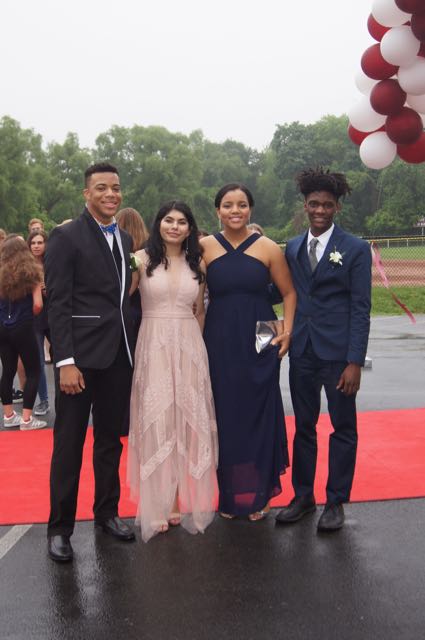

SHS Alum Andrew Weber Speaks on Countering Weapons of Mass Destruction
- Details
- Written by Sarah Kazan and Derek Moritz
- Hits: 5311
 Associate Village Justice Cindy Dunne and Andrew Weber The League of Women Voters annual spring luncheon on Friday May 18 featured Scarsdale alumni Andrew C. Weber who gave a captivating presentation about “Countering Weapons of Mass Destruction.” He gave a revealing explanation about the wide range of nuclear, biological and chemical weapons that are currently being produced and stored around the world.
Associate Village Justice Cindy Dunne and Andrew Weber The League of Women Voters annual spring luncheon on Friday May 18 featured Scarsdale alumni Andrew C. Weber who gave a captivating presentation about “Countering Weapons of Mass Destruction.” He gave a revealing explanation about the wide range of nuclear, biological and chemical weapons that are currently being produced and stored around the world.
Weber explained his career trajectory to foreign service. After graduating from Scarsdale High School in 1978, he attended Cornell University and now holds a Master of Science in Foreign Service (MSFS) degree from Georgetown University, where he also taught a course on Force and Diplomacy for eight years. Weber dedicated thirty years of his life to working with the US government, including five and a half years as President Obama’s Assistant Secretary of Defense for Nuclear, Chemical, and Biological Defense programs. In addition, he was an essential part of the Nunn-Lugar Cooperative Threat Reduction efforts to remove weapons-grade uranium from Kazakhstan and Georgia and nuclear-capable aircrafts from Moldova, reduce biological weapons threats, and destroy Libyan and Syrian chemical weapons stockpiles. He was also on the US leadership of the international Ebola response for the State Department. He is now an independent consultant and a strategic advisor for IP3 International and Ginkgo BioWorks. Weber serves on the Board of the Arms Control Association and the James Martin Center for Nonproliferation studies International Advisory Council and is a member of the Council on Foreign Relations.
League President Janice Starr opened the event by describing the League’s importance to the community and recognizing elected officials present including Benjamin Boykin, Amy Paulin, Dan Hochvert, Arlene Katz, Jane Veron and candidate for Congress Jonathan Lewis. Cindy Dunn then introduced Weber.
Weber’s stories sounded like the scripts of films, and indeed, his work removing uranium form Kazakhstan is now being detailed in a movie script.
Weber explained, that while serving his thirty years in the US government, he worked on the Nunn-Lugar Project to dismantle weapons of mass destruction (WMD) lying dormant throughout the Soviet union. While returning from assignment in Germany in 1992 he saw an ad in a newspaper that stated: “Looking for diplomats who find Paris a bore”. Former and Current Presidents of the League of Women Voters
Former and Current Presidents of the League of Women Voters
He answered the ad, and in 1993, he traveled to Kazakhstan, which was the fourth largest supplier of WMD’s at the time. He collected samples of water, soil, and plants to check radiation levels from former nuclear testing. But while in Kazakhstan, he was also approached by a car salesman, who asked if he wanted to buy any uranium. Intrigued, he met the factory director of the plant holding the uranium, who took him on a hunting trip to gain his trust. Weber learned that the factory held 600 kg of weapons grade uranium left over from former Soviet projects. With the cooperation of the Kazakhstan government, Project Sapphire was organized to safely transport these nuclear materials away, as they were poorly secured and at risk of being sold to construct nuclear weapons. Weber explained that transporting these materials was extremely dangerous, as the roads were covered in black ice. The materials were eventually taken to a C5 galaxy aircraft which flew nonstop to Oak Ridge, CA, where they material was converted to energy to be used at a power plant. Thanks to Project Sapphire and similar denuclearization efforts, the world went from having 50 countries with enriched uranium/plutonium to only 20 countries with enriched uranium/plutonium.
Similar to nuclear weapons, Weber oversaw the elimination of biological weapons. He visited another factory in Kazakhstan which had ten four story high fermenters of anthrax, with 300 tons in total. Thanks to the Nunn-Lugar program, he worked with the Kazakhstan government to dismantle the factory, which is now a field of grass. He also traveled to Renaissance Island, a former territory of the Soviet Union used to test biological weapons on monkeys to determine their effectiveness. They found 100 tons of buried anthrax, and worked with the government of Uzbekistan to eliminate the cultures. While the Nunn-Lugar program has helped significantly reduce the worldwide number of biological weapons, Weber’s fear moving forward is the role technology will play in creating advanced biological weapons that could be drug resistant.
Weber also warned of the necessity to eliminate chemical weapons. In 1997, all but four countries (Israel, Egypt, South Sudan, and North Korea) ratified a convention to eliminate the use of chemical weapons. In 2014, he oversaw the destruction of the last of Gaddafi's chemical weapons in Libya, mainly mustard gas. The UN also oversaw the destruction of 1,300 tons of Sarin and VX Nerve gas in Syria. Weber noted that Assad has been mostly using chlorine gas on civilians in Syria, and still has a small amount of Sarin. He also mentioned that Fentanyl, a synthetic opioid painkiller, is also a chemical weapon, and was used in 2002 by Russian forces to clear a theater occupied by Chechen terrorists, but inadvertently killed innocent theater-goers. He cautioned that despite the convention, chemical weapons are still a significant threat, as North Korea contains over 5,000 tons of chemical weaponry and leaders such as Assad have shown zero hesitation in using these weapons on civilians.
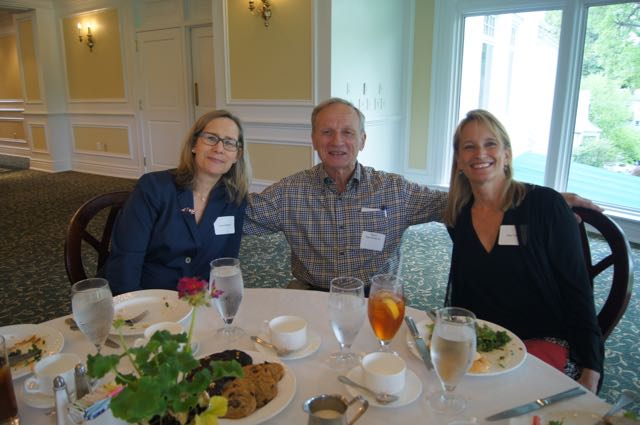 Scarsdale Mayor Dan Hochvert With Two FriendsBesides chemical weapons, Weber advocated to stop the production of new nuclear weapons. The world currently has 15,000 nuclear weapons, and creating more could lead to another arms race that would further destabilize the world. President Trump departed from forty plus years of foreign policy to reduce nuclear capabilities, and instead has decided to spend trillions on the production of more nuclear weapons moving forward. He has taken on a policy similar to Putin, which is to create smaller nukes that are “more usable”.
Scarsdale Mayor Dan Hochvert With Two FriendsBesides chemical weapons, Weber advocated to stop the production of new nuclear weapons. The world currently has 15,000 nuclear weapons, and creating more could lead to another arms race that would further destabilize the world. President Trump departed from forty plus years of foreign policy to reduce nuclear capabilities, and instead has decided to spend trillions on the production of more nuclear weapons moving forward. He has taken on a policy similar to Putin, which is to create smaller nukes that are “more usable”.
Policies such as these have lead for the doomsday clock, a measure of global stability, to only be two minutes to midnight, or doomsday. Factors included when calculating how many minutes the world is to midnight include nuclear threats, climate change, biosecurity, bioterrorism, and miscellaneous threats. Weber specifically noted that Trump’s funding for two new nuclear cruise missiles, which are guided to their targets via a computer, are especially unnecessary. Weber has been working for an arms control agreement throughout the world to eliminate this dangerous class of cruise missiles. Locally, Weber said that Representative Nita Lowey and Senator Gillibrand have specifically supported the defunding of new nuclear weapons, and hopes that young people will take a similar stand. He ended by encouraging young people to pursue a career of public service, and quoted President Carter “We must not let these weapons of the 20th century darken the skies of the 21st century.”
Weber began to take questions from the audience, and addressed the recent outbreak of Ebola in the Congo, and how the Soviets had developed Ebola as a chemical weapon. Luckily, he mentioned that this outbreak can be contained more gracefully than recent cases. Weber was the former Deputy Coordinator for the Ebola Response at the U.S. Department of State. In this position Weber was responsible for leading diplomatic outreach efforts to ensure a speedy, effective, and global response to the crisis. He was part of an effort with 70 countries to control the outbreak. A vaccine has been developed and licensed, something that they did not have access to at the beginning of the last crisis. He noted that this vaccine is now available and very effective; if deployed quickly enough they can stop the outbreak before it becomes a major epidemic.
In his time in the US government, they set up a new office devoted to combating global disease. However, since President Trump has taken office, National Security Advisor John Bolton has eliminated this office. Even though the Centers for Disease Control and Prevention (CDC) is still dedicated to eradication global diseases, Weber remarked “We need leadership but its not there… this was a really unfortunate mistake.” One lesson he has learned in his thirty years in US government is that the US cannot do anything on its own and relies heavily on its partners, for example the Ebola crisis and eliminating uranium from Kazakhstan and Syria were all team efforts with other nations. Unfortunately, he said, “there is a leadership vacuum, there is no one inline behind the US to lead on these important issues.” The Current Board of the League of Women Voters
The Current Board of the League of Women Voters
On the advancements of new technologies, Weber spoke on what precautions nations must take. “Technology is a blessing and a curse,” he warned. His biggest concern of new technology is that nations must understand the dangers of technology and globally there has to be an established norm, how nations use and control it. He is mainly concerned about the norm against WMDs which are now being used in Syria and North Korea; a norm against use of these weapons which used to be very strong now seems to be breaking down, which in Weber’s view is a “very scary prospect.” When a member of the audience asked if there is good will on both sides to establish a norm, Weber responded optimistically. He pointed out that there used to be five rouge states the US had to worry about, and now there are only two. With North Korea, his theory of dictators is they can move and change direction easily, there is no congress or legislation they have to worry about, however, the best way to get through to these leaders is talking to them directly. Already, world leaders have met with Kim Jong Un, including an upcoming meeting between Kim and President Trump. Kim has already agreed to close his testing sites for nuclear weapons and will stop missile launchings. Weber pointed out that Kim has seen economic prosperity in other nations, to Weber this means that Kim will potentially realize he is in a strong position to negotiate peace and even opening up trade. Weber acknowledged that this will be a very long road but the US has experienced this type of negotiation before in Russia and Kazakhstan. These first steps have shown promise to Weber.
Another way to reduce risk of nuclear war pointed out by Weber is to increase decision times. In his opinion, decision times are too short and anything that can be done to increase this time would lessen the risk of nuclear war. He also noted that both Putin and the US are using smaller nuclear weapons in regional exercises which increase the probability of a misunderstanding. A suggestion to curb this risk, Weber mentioned, is for Trump to sit down and talk to Putin; this is the only practical way to walk ourselves back from this arms race. Trump's nuclear weapons plan would cost $1.7 trillion over the next three years; Weber believes the government must evaluate spending and focus on other priorities rather than spend and exorbitant amount on nuclear weapons.
On Iran, Weber hopes that Europe, Russia, and China can keep the Iran agreement on life support without the United States. The agreement allowed for 98% of uranium to be removed from the country, the nuclear reactor to be filled with concrete, a majority of centrifuges to be taken offline, and underground facilities to close. Many of these terms, including the removal of Uranium, could never have been done militarily. The agreement also allowed for intrusive inspections that would never allow Iran to pursue a nuclear weapon. By pulling out, the US risks losing access and knowledge to Iran’s nuclear capabilities.
 Linda Doucette-Ashman and Joan BowenWeber knew he wanted to work overseas, and pursued International Affairs at Cornell because he knew a foreign language. He pursued his education about foreign service at Georgetown and went overseas after a year of training, where there are many more opportunities available. Weber is passionate about getting young people excited about and involved with global service. He stated “It’s an incredible thing to be part of something that can be such a force of good in the world.”
Linda Doucette-Ashman and Joan BowenWeber knew he wanted to work overseas, and pursued International Affairs at Cornell because he knew a foreign language. He pursued his education about foreign service at Georgetown and went overseas after a year of training, where there are many more opportunities available. Weber is passionate about getting young people excited about and involved with global service. He stated “It’s an incredible thing to be part of something that can be such a force of good in the world.”
The next project Weber will embark on is working on a movie about his experience in Kazakhstan. He was approached by two co producers who were passionate about telling his story. The screenplay should be finished within the month, then the team will be able to move forward to find a director and be able to tell Weber’s story through his eyes.
Besides working on the movie, Weber will continue to work to remove armed missiles throughout the world. He plans to work in consulting in the Biotech sector to ensure new capabilities are not misused, and may re-enter teaching.














